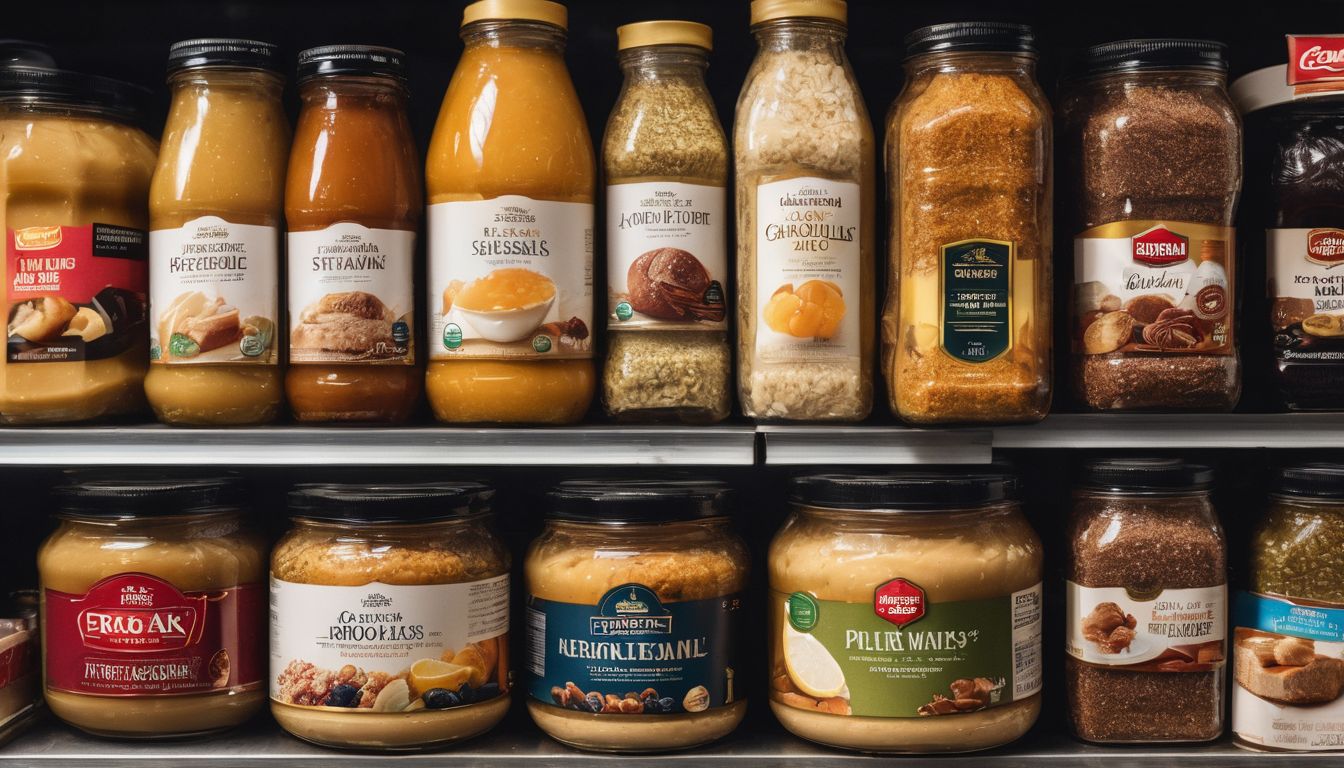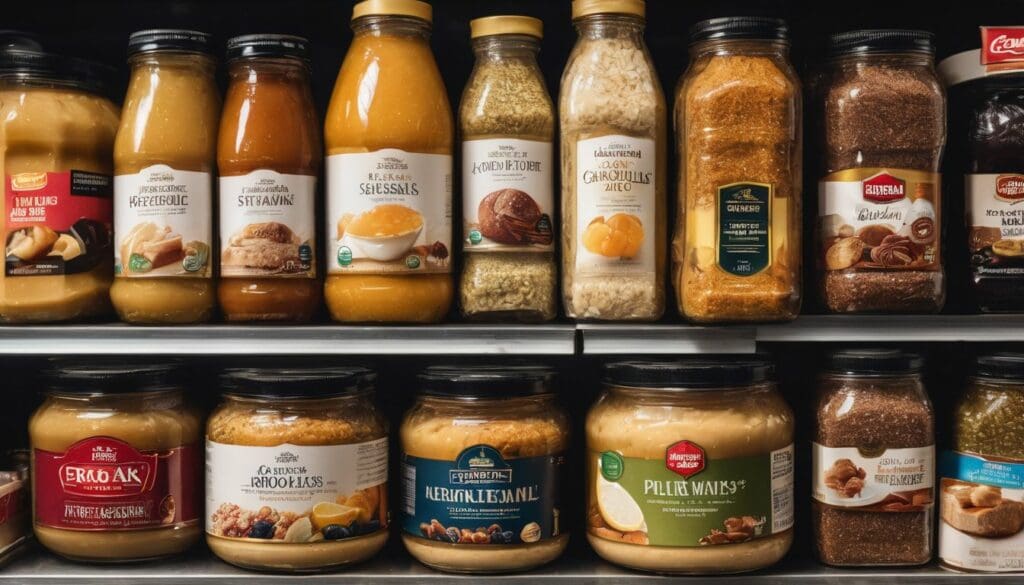 Deciphering food labels can feel like a puzzle when trying to make healthier choices. A staggering 68% of consumers find food labels to be both complex and misleading. This guide will demystify the jumble of numbers and words, empowering you with the knowledge to choose wisely for your diet.
Deciphering food labels can feel like a puzzle when trying to make healthier choices. A staggering 68% of consumers find food labels to be both complex and misleading. This guide will demystify the jumble of numbers and words, empowering you with the knowledge to choose wisely for your diet.
Discover how to eat smarter, starting now.
Understanding Food Labels
Understanding food labels is crucial for making informed decisions about the products we consume. This section will cover the different types of food labeling, including front-of-package, side and back-of-package labeling, as well as related resources from the FDA.
The Nutrition Facts Label
The Nutrition Facts Label serves as your guide to making smart food choices. It details the nutritional content of a product, allowing you to assess how it fits into your healthy diet.
Look for key information like calorie count, serving size, and nutrients such as fats, sugars, protein, and vitamins. This label helps track which foods align with your environmental values by revealing ingredients and potential preservatives.
Checking the percent Daily Value (%DV) gives insight into how much a nutrient in a single serving contributes to a daily diet. Use this percentage to gauge whether a food item is high or low in specific nutrients beneficial for conservation-minded eating habits.
Nutrient content claims on packaging can also influence purchasing decisions – opt for items that support both health objectives and ethical food production practices without giving up on taste or quality.
Front-of-Package labeling
Front-of-Package labelling provides a quick snapshot of key nutritional information. It includes details on calories, saturated fat, sodium, and added sugars for a single serving. Look out for colour-coded labels or symbols that indicate if the product is high, medium, or low in certain nutrients to make informed choices about your food purchases.
These labels are designed to be user-friendly and help you quickly identify products that align with your dietary preferences and health goals.
Front-of-Package labelling aims to provide easily accessible information on the nutritional content of food products. This system empowers consumers to make healthier choices by highlighting critical nutritional facts at a glance and supports individuals who prioritise their health and sustainable living practices through mindful consumption.
Side and Back-of-Package labeling
Now that you’ve familiarised yourself with the information on the front of food packaging, let’s delve into the side and back-of-package labelling. This is where you’ll find detailed nutritional information, ingredient lists, allergen warnings, and more.
These labels provide essential details for making informed choices about your food consumption, helping you to align your diet with your environmental values. You can use this information to ensure that the products you choose are sustainably sourced and free from environmentally harmful additives.
Understanding these labels empowers you to make eco-conscious decisions that support conservation efforts while also prioritising your health and well-being.
Related resources from the FDA
Transitioning from understanding food labels to accessing related resources, the FDA offers valuable information for environmentally conscious individuals. The FDA website provides comprehensive details on food labeling regulations and guidelines, helping consumers make informed choices about the products they purchase.
By exploring these resources, you can gain a deeper understanding of nutrition content, allergen information, health claims, and certified organic products. Additionally, the FDA’s guidance on energy labeling and product date marking can further support your commitment to healthy eating while promoting environmental conservation.
How to Read and Use the Nutrition Facts Label
Understanding how to interpret serving sizes, calories, nutrients, and percentage daily values on the Nutrition Facts Label is essential for making informed food choices. Click here to delve deeper into this important aspect of understanding food labels.
Serving information
The serving size on a food label tells you the recommended portion for that particular product. It’s important to pay attention to this information since it influences the rest of the details on the label.
Serving sizes can differ from one brand to another, so always check this section when comparing products. The serving information allows you to understand how many servings are in a package and how many calories and nutrients are in each serving – helping you make informed choices about what and how much to eat.
Understanding what constitutes a single serving can assist in managing your calorie intake efficiently. By looking at the number of servings per container and checking against your typical portion size, you can better control your consumption of calories, nutrients, and additives like allergens listed for healthier eating habits.
Percent Daily Value (%DV)
The Percent Daily Value (%DV) on food labels shows how much a nutrient in a serving of food contributes to a daily diet. It helps individuals understand if the serving size contains high or low levels of specific nutrients.
This information is crucial for making informed choices about what to consume. By paying attention to %DV, you can easily see if a food item has higher or lower amounts of specific nutrients and adjust your dietary intake accordingly.
Moving on to understanding ingredients and additives..
Variations in Nutrition Facts Labels
Different types of food products are regulated differently, leading to variations in the nutrition facts labels. It’s important to be aware of these differences and understand how they may impact your food choices.
Different types of labels
Food labels come in various forms, each providing different types of information to help consumers make informed choices. The Nutrition Facts Label provides detailed information about the nutritional content of a product, including serving size, calories, and nutrients like fat and sugar.
Front-of-Package labelling highlights key nutrition information at a glance, while side and back-of-package labelling often contains more detailed information such as ingredient lists and allergen warnings.
Understanding these different types of labels can empower environmentally conscious individuals to make sustainable food choices that align with their values. By being aware of the nuances in food labelling, consumers can better support conservation efforts through their purchasing decisions.
Understanding Ingredients and Additives
Understanding the importance of ingredient lists and compound ingredients. Exploring percentage labeling and how to read the ingredient list for healthier food choices.
Importance of ingredient lists
Ingredient lists play a crucial role in helping environmentally conscious individuals make informed decisions about the products they consume. By understanding the ingredients listed on food labels, consumers can support conservation and environmental efforts by choosing products that align with their values.
Ingredient lists provide transparency about the components of a product, allowing consumers to avoid additives or substances that may have negative environmental impacts.
Furthermore, ingredient lists enable individuals to select products that are healthier for both themselves and the environment. By being aware of what goes into their food, consumers can make choices that promote sustainability and eco-friendly practices.
Percentage labeling
Percentage labeling on food packages provides valuable information about the relative amounts of different ingredients in a product. This can help environmentally conscious individuals make informed decisions about their purchases, ensuring they support conservation and environmental efforts.
By checking percentage labels, you can easily identify if a product contains higher or lower quantities of specific components, allowing you to choose products that align with your values.
Understanding percentage labeling is crucial for making environmentally friendly choices when it comes to the products you buy. It offers transparency and empowers consumers to select items that are produced in an eco-friendly manner, thus contributing positively to conservation and environmental sustainability.
Now let’s delve into how compound ingredients play a role in understanding food labels.
How to read the ingredient list for healthier food choices
When choosing healthier food options, it’s important to understand how to read the ingredient list for better decision-making. Here’s what to look for:
- Look for whole food ingredients – Choose products with real, unprocessed ingredients like fruits, vegetables, whole grains, and lean proteins.
- Check for additives and preservatives – Avoid products with long lists of artificial additives and preservatives as they may have negative health impacts.
- Consider the order of ingredients – Ingredients are listed in descending order by weight, so prioritize products that have healthy ingredients at the beginning of the list.
- Watch out for hidden sugars and unhealthy fats – Be mindful of terms like high-fructose corn syrup, hydrogenated oils, and artificial sweeteners.
- Pay attention to allergens – If you have food allergies or sensitivities, carefully scan the ingredient list for any potential allergens.
- Identify unfamiliar ingredients – Research any unfamiliar or unpronounceable ingredients to ensure they align with your dietary preferences.
- Choose minimal processed foods – Opt for products with minimal processing and avoid those with a long list of chemical-sounding ingredients.
Allergens
Food labels are crucial for individuals concerned about their health and the environment. When checking ingredient lists, be aware of potential allergens such as nuts, milk, eggs, soy, wheat, fish, and shellfish.
Always read food labels carefully to avoid consuming products that contain these allergens if you have allergies or intolerances.
Manufacturers must clearly highlight common allergens in the ingredient list using bold font or a separate allergen statement. This can help environmentally conscious consumers make informed choices and support their health while promoting sustainable practices within the food industry.
Energy labeling
To make informed decisions about the impact of the food we consume, understanding energy labelling is crucial. Energy labels on food products indicate the amount of energy they provide per serving size.
This helps consumers to monitor their calorie intake and make healthier choices for themselves and the environment. By paying attention to energy labels, environmentally conscious individuals can align their diet with sustainable practices, supporting conservation efforts while taking care of their own health.
Understanding energy labelling empowers consumers to make mindful decisions that are beneficial for both personal well-being and environmental sustainability. Being aware of the energy content in food products enables individuals to choose options that align with their values while contributing positively to our ecosystem.
Conclusion
In summary, understanding food labels is crucial for making informed choices about the products we consume. Learning to read and interpret nutrition facts labels and ingredient lists empowers us to select healthier options.
By being aware of additives, allergens, and country of origin, we can make more environmentally conscious decisions that support conservation efforts. Taking the time to understand food labels is a simple yet impactful way to contribute positively to our health and the environment.





